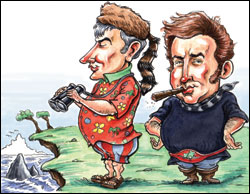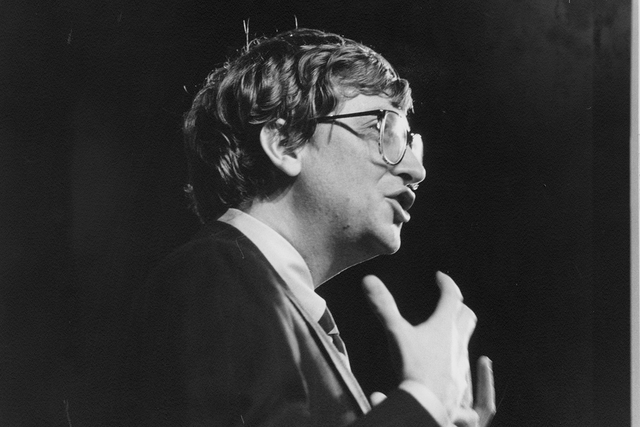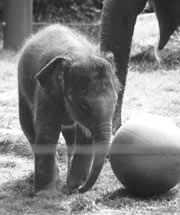THIS BICENTENNIAL is just approaching the starting gate, and already it’s in overdrive. Exactly 200 years ago this month, Capt. Meriwether Lewis set out on his epochal expedition across a mysterious continent and made it all the way toPittsburgh. There he gathered supplies and tried to get a boat built to float down the Ohio River and prepare for the real journey. The boatbuilder balked and fumbleda less than glorious beginning. Never mind. Two hundred years later, the bicentennial hype is chugging along under full steam.
No paltry National Sacagawea Week or Lewis and Clark Month here; President Bush has proclaimed a four-year celebration of the Voyage of Discovery, through 2006. Nearly every state, town, and visitors center in the journey’s path is scrambling to clamber aboard and, in the words of USA Today, “grab a piece of the huge tourism pie associated with the 200th anniversary.” In October, Louisville, Ky., will stage a re-enactment of Lewis and Clark’s rendezvous. Next May, Wood River, Ill., will re-enact the Corps of Discovery’s departure after wintering. St. Charles, Mo., will re-enact the start up the Mighty Mo. Leavenworth, Kan., will re-enact its stop-off to celebrate July 4, 1804, with a blast of the swivel gun and an extra whiskey ration. (Don’t expect free drinks in what’s now one of the driest states in the union.) And so on, with pageants, festivals, symposia, fireworks, and flyovers at 12 more stations of the crossing designated to host “national signature events,” all the way to Fort Clatsop, Ore., and back. Maya Lin, designer of the Vietnam War Memorial and the closest thing this country has to an official artist, will create four sculptures at key Snake and Columbia river confluences for the bicentennial Confluence Project. Where the festivities go, newspapers and networks will surely follow; The Seattle Times, which maintains a Web page for breaking Lewis and Clark news, got the jump with nearly seven broadsheet pages in one May week.
Even places with more tenuous connections to the expedition will milk it for all it’s worth. Harper’s Ferry, W.Va., where Lewis stopped to shop, will hold a party and open a permanent Lewis and Clark exhibit. As for this Lewis and Clark heartland, never mind that the heroes passed their most wretched months in the Northwest, grumbling about the rain and rot and “thievishly inclined” natives (who were already expert at dealing with thievishly inclined white traders). Never mind that they fled the Washington side of the Columbia River for Oregon, where the game was better. We can expect a continuing rich diet of Lewis lore and Clark kitsch.
At untold points between, more Lewis and Clark centers will open, and more reincarnated explorersmany more than composed the original Corpswill turn out in three-corner hats, buckskin tunics, and elk-hide moccasins to sample the joys and a few of the ardors of roughing it 1805-style. Even before the bicentennial boom, the Corps of Discovery was second only to the Civil War as a refuge for those generational cross-dressers known as historical re-enactors.
THE PILGRIMS and Pocahontas are pass鬠and Columbus has been tarnished. But the Lewis and Clark Expedition endures as our favorite national creation mythmore cherished even than the Revolution and constitutional birth pangs that established the republic, perhaps even more sacrosanct than the Civil War. If the Civil War is our Iliada sprawling tragedy of war and purgationthen the Voyage of Discovery is our Odyssey: a more intimate epic of discovery, survival, and redemption, and everything else Hollywood loves.
It’s easier to like The Odyssey than The Iliad. Like The Iliad and the Civil War, the Revolution and Constitutional Convention are messy affairs, crowded with murky characters, mixed motives, and political crosscurrents. Though they happened just a few years before the expedition, they seem much more distant. Their heroesWashington, Franklin, Madison, Lincolnare marble eminences, lofty and unapproachable.
But Meriwether Lewis and William Clark are perfect epic heroesordinary guys summoned to an outsized mission, the first Boy Scouts, our own Frodo Baggins and Sam Gamgee. Theirs seems a pure and simple quest, moral clarity incarnate. They appeal to both the anarchic and patriotic elements of American vanity: They light out for the country like Huck Finn and, at the same time, bear the nation’s destiny in their steady hands. Their heroism is tempered and highlighted by their sympathetic weaknesses: Lewis’ fierce mood swings and Clark’s notoriusly haphazzird spelinge. As George W. Bush well knows, we like our heroes to trip over the language now and then. Brings ’em down to our level.
FOR BUSH, PRESIDING over this patriotic joyfest is one more in a run of lucky breaks. Lewis and Clark suit his administration’s agenda better than any spectacle Karl Rove could concoct. When the Corps of Discovery reached the Pacific, staking a claim to the “Ouragon country,” the United States became a continental power and embarked on the path to global power. The first steps toward Texas and California, Cuba and the Philippines, Kabul and Baghdad, were paced along the Missouri Valley in the spring of 1804. Thomas Jefferson’s proto-imperialist venture, so contrary to his anti-imperialist principles, glows brighter than ever in an era of unabashed neo-imperialism. His continental ambitions, and the stratagems and rationalizations employed to achieve them, offer a legitimizing precedent to the global-supremacist ambitions of Cheney, Rumsfeld, Rice, and Wolfowitz.
Not that exploiting the explorers for latter-day ends is anything new. Lewis and Clark have gone in and out and back into fashion; each era exalts, forgets, revives, or remakes them according to its needs. They returned in 1806 as national heroes, but Lewis died three years later, mired in political and financial woes, and Clark became better known for his subsequent work as superintendent of Indian affairs in the West. A tardy distillation of their voluminous journals, ghostwritten by Nicholas Biddle, appeared in 1814 and flopped. The journals disappeared from view for eight decades. Then, in 1893, Biddle’s version was reprinted. The full journals were finally published in 1904. Blockbuster expositions in St. Louis and Portland marked the centennials of the Louisiana Purchase and the expedition. The twin captains were heroes again; their expansive mission suited both the populist and the imperialist currents of Teddy Roosevelt’s America.
THE PRINCESS GUIDE
Even Sacagawea, the Shoshone teenager who served as interpreter in the crucial passage over the Rocky Mountains, was taken up by a new cause and elevated to a new status. In 1902, Eva Emery Dye, chair of the Oregon Equal Suffrage Association, published a popular novel extolling “Sacajawea” as the “Madonna of the expedition” and the “woman pilot” who guided it through the wilderness. “Across North America,” Dye wrote, “a Shoshoni Indian princess touched hands with Jefferson, opening her country.”
In a study of the Sacagawea myth, Ella E. Clark and Margot Edmonds recount that Dye sought a historical figure to embody her proto-feminist vision. “Finally,” Dye declared, “I came upon the name of Sacajawea, and I screamed, ‘I have found my heroine!'” And, she added proudly, “the world snatched at my heroine.”
Indeed. Dye’s The Conquest arrived just as the Lewis and Clark revival and women’s suffrage movement gathered to a boil. The movement’s leading voicesthe National Woman Suffrage Association, Susan B. Anthonyadopted Sacagawea as a founding spirit. Dye urged the erection of one Sacagawea statue; several went up, from St. Louis to Portland. In 2000, Sacagawea replaced Anthony on the dollar coin. Other novelists, journalists, and academics picked up the tale of wise Sacagawea guiding the heroes to the Pacific. You probably learned it growing up; I know I did. It’s a lovely talebut unsupported by the expedition journals and probability. Carrying her newborn son all the way, Sacagawea was certainly a stalwart member of the troopClark’s journal lauds her as such, though Lewis refers to her dismissively. When her feckless French husband spilled Lewis’ important parcels from a foundering canoe, she calmly retrieved them. She filled a link in the multilingual chain of translation through which Lewis and Clark communicated with various tribes as they descended from the Rockies to the Columbia. Her presence might have defused suspicion, even confrontations; as Clark noted, “A woman with a party of men is a token of peace.” And she did recognize a couple of key landmarks on the return trek, reassuring the crew.
BUT “GUIDE”? At most, she could have shown them through the Shoshone country, from which she’d been abducted at around age 12. But Lewis (rashly, perhaps) didn’t take her in the advance party to locate the Shoshones. And the explorers induced two older Shoshones to guide them down from Lemhi Pass.
Sacagawea the Guide is merely the most conspicuous of the myths that have come to limn the Lewis and Clark story. Others are more significant but less obvious. To examine them is not to debunk or dismiss the real and remarkable achievements of the Corps of Discovery. But an unexamined myth is a travesty of the events and personages from which it springs, and when a myth is as potent as this one, a danger to those who live by it.
The enduring reverence for Lewis and Clark rests on two essential grounds: the courage and sacrifice that went into the trip and the benefits that flowed from it. It has come to stand as the supreme real-life heroic quest, an unprecedented journey of incomparable peril and difficulty, and a matchless contribution to science and the evolution of the nation. Alone and unaided, these moccasin-clad incarnations of the can-do American spirit conquered a virgin wilderness and opened its secrets to the world. On both scores, the truth is more complicated and perhaps less glorious.
THE FIRST STEPS
The Voyage of Discovery was indeed a long, often grueling slog. But it was less punishing and much less deadly than nearly all the great seagoing explorations and many humble commercial voyages. It was hardly as astonishing a saga of survival against the odds as, say, Shackleton and the Endurance crew’s escape from Antarctica with “not a man lost.”
Yes, that’s to the credit of Lewis’ planning and both captains’ prudent leadership; Shackleton only got his chance at glory because he got stuck in the ice. But Lewis, whose sensitive ego was on the line, hyped the expedition from the start, writing that he was “now about to penetrate a country of at least two thousand miles in width, on which the foot of civilized man had never trodden.” (The actual area that Europeans aren’t known to have entered was about 1,000 miles wide.) And theirs was neither the first nor the most arduous crossing of the continent. Three centuries earlier, the shipwrecked bookkeeper Cabeza de Vaca trudged across Texas, the Southwest, and the deserts of northern Mexico, emerging eight years later far down the Pacific Coast. In 1789, the Scottish fur trader Alexander MacKenzie set out across Canada for the Pacific. After detouring to the Arctic along the river that bears his name, MacKenzie returned and set out again, with a much smaller, less equipped party than Lewis and Clark’s, over rougher and less-known terrain, and reached Fitzhugh Sound on the coast of what today is northern British Columbia.
As for “courage undaunted” (Jefferson’s encomium to Lewis and Clark), consider the audacity of another of Jefferson’s doomed prot駩s, the Connecticut-born adventurer John Ledyard, who might have given Jefferson the idea of crossing the continent. Ledyard, who sailed to the Northwest with Capt. Cook, longed to return, open the fur trade there, and then head east. In 1785, Jefferson, in Paris, urged Ledyard to make it a round-the-world trek, via Siberia, and promised to secure safe passage from Russia’s Empress Catherine. When other recourses failed, Ledyard trudged alone through Germany, Sweden, Lapland, and Finland in the middle of winter, hitchhiked across Russia and Siberia, and awaited a ship to Nootka Sound.
LEDYARD TRAVELED LIGHT, with a hatchet, an Indian pipe (for peace smoking), and two dogs. Stephen Ambrose, whose best-selling Undaunted Courage fueled the latest Lewis and Clark craze, sneered at Ledyard’s “absurd idea.” But it had logic as well as chutzpah. He couldn’t carry enough trade goods, guns, and ammunition anyway, and the less he carried, the less he’d fear robbery. The dogs could help pack what he had, catch game, protect him, and even keep him warm.
Next to that, the Corps of Discovery was a loaded cruise ship: nearly 2 tons of food, medicine, trade goods, and weapons (with enough lead and powder for two trips), in a 55-foot keelboat, two pirogues, and sundry canoes. With the latest rifles, four swivel guns, and an air gun (probably rapid-fire) to awe the natives, it was the best-armed force ever seen on the plains. Rather than tramping Ledyard-style, the Corps sailed, barged, and paddled most of the way up the Missouri, down the Snake and Columbia rivers, then back again. In between, it desperately needed, and luckily obtained, Indian horses. Hauling that gear and buying enough buffalo humps, dried salmon, and wapato roots to feed that troop were among its biggest challenges.
Ledyard might have made it, if Catherine hadn’t had him arrested as a French spy and shown to the Polish border. Wealthy English backers then recruited him to attempt the first expedition deep into Africa, with the modest goal of finding the source of the Nile, crossing the continent at its widest, and finding the source of the Niger. Still undaunted, Ledyard again set out alone. Jefferson hoped he’d survive and complete the North American crossing. But he took sick and died in Cairo.
Jefferson lamented the loss and sponsored another would-be continent crosser, who was unmasked as a French spy. He then groomed a new prot駩, Meriwether Lewis. To the lucky goes the glory; Ledyard’s path was as star-crossed as Lewis and Clark’s was blessed, until Lewis’ bitter end.
FRONTIERS OF KNOWLEDGE
Today, the Voyage of Discovery’s most celebrated achievements are its scientific ones. Tutored by Jefferson, Lewis proved a brilliant naturalist, and Clark was a gifted cartographer. They studied, measured, and recorded more thoroughly than any expedition had before and returned with a trove of new botanical, zoological, geographic, and ethnological findings no other expedition has matched.
But these failed to make the scientific contribution they should have, partly through the gatherers’ failures of imagination and partly through the hazards of publishing and an epic case of writer’s block. A year after his return, Jefferson appointed Lewis governor of the Louisiana Territory, a post that was supposed to be an honor but proved a torturous hot seat. Beset from many sides, Lewis apparently never started his heralded account of the expedition, though he claimed it was nearly done. No wonder so many writers find him sympathetic. He finally skipped his deadline for good, with bullets to the chest and head.
Ghostwriter Biddle completed a tardy, posthumous account exemplary in most ways but omitting Lewis’ botanical and zoological data. Dr. Benjamin Smith Barton, who’d coached Lewis before the trip, was to render these into another volume. But Barton dithered and died. Lewis’ findings languished for nearly a century.
A botanist hired to draw illustrations appropriated Lewis’ plant samples and included 124 in a European volume on American flora. But he lacked the ecological datalocation, habitat, season, etc.that Lewis compiled and science required. Some of Lewis’ zoological discoveriesthe grizzly, pronghorn, coyote, and prairie dog, for starterswere too big to overlook and were quickly disseminated. But much of what he painstakingly compiled was effectively lost, leaving others to reprise his discoveries. The expedition is the story of a world lost as well as found.
THE HUMAN FACTOR
Lewis and Clark scrupulously recorded what historian James Ronda calls “the externals of native life”: dress, homes, crops, languages, marital and sexual customs, and especially data of commercial and political interest (their numbers, where they lived, what they hunted, their alliances and rivalries). They disregarded other areas that Jefferson wanted them to explore, such as cultural and religious lives, myths, ceremonies, and beliefs.
They don’t seem to have gained insight into a fundamental question that fascinated Jefferson: Where did the “Indians” come from? Jefferson didn’t buy one popular notion, that the Twelve Lost Tribes of Israel were wandering the West, but he was drawn to another: that some Indiansperhaps the Mandans, who were sometimes unusually fair-skinnedwere wandering Welshmen. The Corps uncovered no Welsh Mandans but thought they heard a Welsh burr in the throaty speech of the Bitterroot Salish.
By contrast, John Ledyard, observing physical and cultural similarities between Siberian and American natives, posited what was then a radical theory: that the ancestors of America’s Indians came over from Siberia. He hoped to find confirmation when he crossed America.
Ledyard showed notable empathy and ready rapport in dealing with what were then called “savages”perhaps more than Clark and certainly more than Lewis. Compared to Spanish conquistadors, or the first Russian promyshleniki to ravage the Aleuts, Lewis and Clark were sensitive saints. And their journals are filled with vivid, even touching scenes of cross- cultural encounters and campfire bonhomie. But they never seemed to quite get it. They judged savages noble if they were compliant; those with minds of their own and an inkling of the danger these white strangers represented were “assumeing and disagreeable.”
Lewis and Clark by turns grossly over- and underestimated their impact on the Indians. They expected proud, suspicious Sioux and Hidatsas to be awed by gun displays; the warriors were merely offended. But as Clark approached a Umatilla village where the people had never seen whites or heard gunfire, he blithely shot a passing crane. (Corps members tended to shoot first and think later, to Lewis’ painful regret when one mistook his rump for an elk’s.) Clark wondered why the villagers had shut their doors. He pushed one open and found 32 Umatillas cowering in terror.
TAKE US TO YOUR LEADER
Jefferson’s first passion might have been the trip’s scientific possibilities, but the overarching goal was more practical: political, commercial, and, if necessary, military conquest. Lewis and Clark were trade junketeers and gunboat diplomats. They were sent to assert control of the new territory, impress the tribes with American might and wealth, urge them to stop fighting each other and submit to their “new father” in Washingtonor else. Make business with us, not war with each other. If this sounds a lot like the recent U.S. global agenda, from NAFTA and GATT to the Bush supremacy doctrinewell, it is. And how Lewis and Clark and their successors fared with the tribes in the 19th century might afford some insight into how the United States might fare in the world as the 21st unfolds.
To lure them away from British fur traders and into the St. Louis trading orbit, the two captains flogged their mission with poignant persistence, smoking endless pipes in one tepee, wickiup, earth house, and cedar-plank lodge after another. Again and again they donned epaulets and swords and read canned speeches to mystified tribesmen, passed out presidential peace medals, and trotted out trade goods. They soon discovered that the Plains Indians, especially, wanted two things: blue beads, which ran short despite efforts to foist off other colors, and, more urgently, guns and powder. They plied their native hosts with booze until they reached the Arikaras, who refused it and explained that, as Ronda puts it, “whites who gave Indians alcohol were not friends but were simply interested in seeing natives act the fool.”
The captains would designate one member of each tribe as supreme chief, loading him with gifts and honors and expecting him to speak for everyoneregardless of whether that tribe recognized any such leader. According to Ronda, “The captains were determined to ‘mint’ chiefs whether the American stamp meant anything or not.” These emissaries from the citadel of democracy tried to impose simple authoritarian hierarchies. Their naive presumption ignored complex, often much more diffuse distributions of power and piqued exactly the sorts of rivalries and resentments they wanted to dampen.
Lewis and Clark implored these designated chiefs to travel to Washington, meet their new father, and marvel at America’s multitudes and wealth. Just one, an Arikara, took the offer straightaway. He died en route, as did so many native visitors to the pathogenic hot zone of civilization.
THE CAPTAINS FLAUNTED guns and butter, promising riches to those who acceded and warning that, as Clark recounted, “if they misused us, I or Capt. Lewis could by writing to [the Great Father] have them all distroyed as it were in a moment.” They insisted that various tribal adversaries set aside ancient rivalries, swear peace, and join in a greater American co-prosperity sphere. But they tried to bust one existing concord: the symbiotic ties between the settled, agricultural Arikaras and the nomadic, buffalo-hunting Teton Sioux. The linchpin of Jefferson’s strategy was to break the Sioux hold over Missouri traffic. Lewis and Clark added two other powerful tribes, the Blackfeet and Assiniboins, to form a sort of 1805 axis of evil. What made these tribes threatening, of course, were their weapons of mass destructionfirearms obtained from the British Evil Empire. To contain the Sioux, the captains tried to organize a willing coalition of Plains villagersMandans, Hidatsas, and their enemies, the Arikaras. It was an ambitious plan, not unlike the Bush administration’s schemes for reshuffling the Middle East and forcibly introducing “democracy.” And it proved equally wishful and uninformed.
“With a naive optimism typical of so much Euro-American frontier diplomacy,” writes Ronda, “Lewis and Clark believed they could easily reshape Upper Missouri realities to fit their expectations.” Their hubris soon crashed against those realities. The chiefs murmured diplomatic nothings and, fearing that the Americans would arm their enemies, sensibly determined to get guns and defend themselves. Lewis and Clark assured them the Great Father would protect them. The Indians knew better. And the arms race was on.
Two years later, in 1806, when the captains redescended the river, they saw how the peace they’d stitched together had fared. The whole valley seemed at war: Arikaras versus Mandans, Hidatsas raiding Shoshones, Sioux attacking Mandans. The disappointment seems to have hardened Lewis. Three years later, as governor of the Louisiana Territory, he sent a small army to escort a Hidatsa chief up the Missouri with orders to be ready, should the Arikaras make trouble, “to exterpate that abandoned nation if necessary.”
So much for the first Pax Americana.
THE FIRST UGLY AMERICANS
Thomas P. Slaughter, in his provocative new study, Exploring Lewis and Clark, recounts that a later trader found the Hidatsas “disgusted” at those heroes’ manners and eager to foist the “ill luck” of the gifts they’d bestowed onto their worst enemies. They and other tribespeople were especially horrified at the American practice of flogging soldiers for transgressions.
Lewis, in particular, seemed to grow testy and intolerantright up to the ghastly night of July 28, 1806, when a group of young Blackfeet tried to steal his and several companions’ guns and horses. The Blackfeet offered no violence, and Lewis’ group managed to recover their guns and capture the braves’ horseswhat would have been a desperate emergency was averted. Lewis nevertheless cornered one of the Blackfeet as he fled and shot him dead, and one of Lewis’ companions fatally stabbed another. In a final insult, Lewis draped one of Jefferson’s gift medalsperhaps a peace medal, showing clasped handson one of the Blackfeet bodies.
Earlier, the Corps had stolen a canoe and firewood from friendly Clatsops and scammed natives’ scanty food by scary “magic” tricks with matches and magnets. Lewis raged at what might have been reciprocal pilfering by the Clatsops and threatened to kill them all and burn their houses. Self-righteousness and double standards arose early in this nation’s dealings with others.
Nevertheless, however hotly Lewis reacted, his intentions and Jefferson’s were more benign than those of presidents and commanders who followed. Jefferson even directed Lewis to take a smallpox vaccine for the Indians. But the vaccine soon lost its virility, and pax turned to literal and figurative pox. The first fur traders inspired by Lewis’ early reports were leaving St. Louis just as the Corps returned. Trappers, miners, ranchers, farmers, railroads, and the U.S. cavalry soon followed.
Lewis and Clark were plague Johnnies, harbingers of disaster for the tribes they met, including those who made their journey (and survival) possible. That disaster struck with particular poetic injustice for the Nez Perc鬠who welcomed the expedition (and whites who followed) and tended its horses till it returned the next year. Seventy years later, another generation’s soldiers drove the trusting Nez Perc頦rom their lands.
Two hundred years later, expansionist fever has struck again. This time, the frontier is still commercialwith oil replacing furbut global and political rather than strictly territorial. It lies in any corner of the world where the American writ doesn’t run. The hubris is grander but essentially the same. This administration’s visionaries imagine they can shake, bake, and shuffle regimes in the Middle East just as Jefferson and Lewis imagined rewriting tribal politics on the upper Missouri. Then, bribes and threats failed, and conquest followed. Some things haven’t changed.
AND SO WE PROCEED with Lewis and Clark, celebrating their voyage anew but understanding it no better. Until we do, we will, in writer Slaughter’s words, “keep repeating their journey over and over again.” In his view, Lewis and Clark failedfailed to cross the continent first, to pacify the plains, to understand what they had found. “Lewis knew he had failed,” Slaughter surmises, and the knowledge killed him.
Perhaps, although the list of internal and external torments that could have driven poor Lewis to take his own life is a long one; Clay Straus Jenkinson, in a probing new study, The Character of Meriwether Lewis, weighs many and concludes that the fearless explorer’s personality disintegrated in the passage from civilization to wilderness and back again, to a point where he no longer had “a home in either world.” Let that be a warning to the re-enactors who would follow in his footsteps.
But perhaps Lewis’ knowledge, won at the price of his life, can still benefit us. There might be less to celebrate in the republic’s first spectacular triumph than we like to think, but there’s much more to learn. It’s not just an inspiring tale, but a cautionary one.








